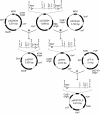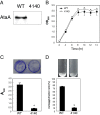A new simple method for introducing an unmarked mutation into a large gene of non-competent Gram-negative bacteria by FLP/FRT recombination
- PMID: 23594401
- PMCID: PMC3654948
- DOI: 10.1186/1471-2180-13-86
A new simple method for introducing an unmarked mutation into a large gene of non-competent Gram-negative bacteria by FLP/FRT recombination
Abstract
Background: For the disruption of a target gene in molecular microbiology, unmarked mutagenesis is preferable to marked mutagenesis because the former method raises no concern about the polar effect and leaves no selection marker. In contrast to naturally competent bacteria, there is no useful method for introducing an unmarked mutation into a large gene of non-competent bacteria. Nevertheless, large genes encoding huge proteins exist in diverse bacteria and are interesting and important for physiology and potential applications. Here we present a new method for introducing an unmarked mutation into such large genes of non-competent Gram-negative bacteria.
Results: Two gene replacement plasmids, pJQFRT and pKFRT/FLP, were constructed to apply the FLP/FRT recombination system to introduce an unmarked mutation into a large gene of non-competent Gram-negative bacteria. In our methodology, pJQFRT and pKFRT/FLP are integrated into the upstream and the downstream regions of a target gene, respectively, through homologous recombination. The resultant mutant has antibiotic resistance markers, the sacB counter-selection marker, flp recombinase under the control of the tetR regulator, and identical FRT sites sandwiching the target gene and the markers on its chromosome. By inducing the expression of flp recombinase, the target gene is completely deleted together with the other genes derived from the integrated plasmids, resulting in the generation of an unmarked mutation. By this method, we constructed an unmarked mutant of ataA, which encodes the huge trimeric autotransporter adhesin (3,630 aa), in a non-competent Gram-negative bacterium, Acinetobacter sp. Tol 5. The unmarked ataA mutant showed the same growth rate as wild type Tol 5, but lost the adhesive properties of Tol 5, similar to the transposon-inserted mutant of ataA that we generated previously.
Conclusions: The feasibility of our methodology was evidenced by the construction of an unmarked ataA mutant in the Tol 5 strain. Since FLP/FRT recombination can excise a long region of DNA exceeding 100 kb, our method has the potential to selectively disrupt much larger genes or longer regions of gene clusters than ataA. Our methodology allows the straightforward and efficient introduction of an unmarked mutation into a large gene or gene cluster of non-enterobacterial Gram-negative bacteria.
Figures





Similar articles
-
Construction of non-polar mutants in Haemophilus influenzae using FLP recombinase technology.BMC Mol Biol. 2008 Nov 11;9:101. doi: 10.1186/1471-2199-9-101. BMC Mol Biol. 2008. PMID: 19014437 Free PMC article.
-
Applications of the Saccharomyces cerevisiae Flp-FRT system in bacterial genetics.J Mol Microbiol Biotechnol. 2003;5(2):67-77. doi: 10.1159/000069976. J Mol Microbiol Biotechnol. 2003. PMID: 12736528 Review.
-
A broad-host-range Flp-FRT recombination system for site-specific excision of chromosomally-located DNA sequences: application for isolation of unmarked Pseudomonas aeruginosa mutants.Gene. 1998 May 28;212(1):77-86. doi: 10.1016/s0378-1119(98)00130-9. Gene. 1998. PMID: 9661666
-
Mini-Tn7 vectors as genetic tools for gene cloning at a single copy number in an industrially important and phytopathogenic bacteria, Xanthomonas spp.FEMS Microbiol Lett. 2009 Sep;298(1):111-7. doi: 10.1111/j.1574-6968.2009.01707.x. Epub 2009 Jun 26. FEMS Microbiol Lett. 2009. PMID: 19659730 Free PMC article.
-
Plasmid vectors for the genetic analysis and manipulation of rhizobia and other gram-negative bacteria.Methods Enzymol. 1986;118:640-59. doi: 10.1016/0076-6879(86)18106-7. Methods Enzymol. 1986. PMID: 3005803 Review. No abstract available.
Cited by
-
Establishment of a Successive Markerless Mutation System in Haemophilus parasuis through Natural Transformation.PLoS One. 2015 May 18;10(5):e0127393. doi: 10.1371/journal.pone.0127393. eCollection 2015. PLoS One. 2015. PMID: 25985077 Free PMC article.
-
An Acinetobacter trimeric autotransporter adhesin reaped from cells exhibits its nonspecific stickiness via a highly stable 3D structure.Sci Rep. 2016 Jun 16;6:28020. doi: 10.1038/srep28020. Sci Rep. 2016. PMID: 27305955 Free PMC article.
-
Development of a Biocontained Toluene-Degrading Bacterium for Environmental Protection.Microbiol Spectr. 2021 Sep 3;9(1):e0025921. doi: 10.1128/Spectrum.00259-21. Epub 2021 Jul 28. Microbiol Spectr. 2021. PMID: 34319138 Free PMC article.
-
The elimination of two restriction enzyme genes allows for electroporation-based transformation and CRISPR-Cas9-based base editing in the non-competent Gram-negative bacterium Acinetobacter sp. Tol 5.Appl Environ Microbiol. 2024 Jun 18;90(6):e0040024. doi: 10.1128/aem.00400-24. Epub 2024 May 9. Appl Environ Microbiol. 2024. PMID: 38722179 Free PMC article.
-
FLP-FRT-based method to obtain unmarked deletions of CHU_3237 (porU) and large genomic fragments of Cytophaga hutchinsonii.Appl Environ Microbiol. 2014 Oct;80(19):6037-45. doi: 10.1128/AEM.01785-14. Epub 2014 Jul 25. Appl Environ Microbiol. 2014. PMID: 25063660 Free PMC article.
References
-
- Simon R, Priefer U, Pühler A. A broad host range mobilization system for in vivo genetic engineering: Transposon mutagenesis in gram negative bacteria. Bio/Technology. 1983;1:784–791. doi: 10.1038/nbt1183-784. - DOI
-
- Hoang TT, Karkhoff-Schweizer RR, Kutchma AJ, Schweizer HP. A broad-host-range Flp-FRT recombination system for site-specific excision of chromosomally-located DNA sequences: application for isolation of unmarked Pseudomonas aeruginosa mutants. Gene. 1998;212:77–86. doi: 10.1016/S0378-1119(98)00130-9. - DOI - PubMed
Publication types
MeSH terms
Substances
Associated data
- Actions
- Actions
LinkOut - more resources
Full Text Sources
Other Literature Sources
Research Materials

